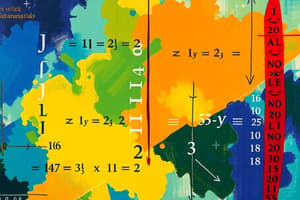Podcast
Questions and Answers
What is the primary purpose of algebra?
What is the primary purpose of algebra?
- To manage large datasets
- To study geometric shapes
- To solve equations and understand relationships (correct)
- To perform statistical analysis
Which of the following represents a linear equation?
Which of the following represents a linear equation?
- 2x² + 3x + 5 = 0
- x² + 5 = 10
- x³ - 4 = 0
- 3x + 2 = 8 (correct)
What do you call the expression 2x + 5?
What do you call the expression 2x + 5?
- A variable
- A constant
- An equation
- An algebraic expression (correct)
Which operation is performed first in the expression 3 + 5 × 2?
Which operation is performed first in the expression 3 + 5 × 2?
What is the factored form of the expression x² - 9?
What is the factored form of the expression x² - 9?
What type of equation is represented by ax² + bx + c = 0?
What type of equation is represented by ax² + bx + c = 0?
In the inequality 2x + 3 > 7, what is the solution for x?
In the inequality 2x + 3 > 7, what is the solution for x?
What is a characteristic feature of quadratic functions when graphed?
What is a characteristic feature of quadratic functions when graphed?
Flashcards are hidden until you start studying
Study Notes
Algebra
-
Definition: A branch of mathematics dealing with symbols and the rules for manipulating those symbols; it is about solving equations and understanding relationships.
-
Basic Concepts:
- Variables: Symbols (like x, y) that represent unknown values.
- Constants: Fixed values (like 2, -3).
- Expressions: Combinations of variables, constants, and operators (e.g., 2x + 3).
- Equations: Mathematical statements asserting equality (e.g., 2x + 3 = 7).
-
Operations:
- Addition, subtraction, multiplication, and division can be performed on algebraic expressions.
- Order of operations (PEMDAS/BODMAS) must be followed.
-
Types of Equations:
- Linear Equations: Equations of the first degree (e.g., ax + b = 0).
- Quadratic Equations: Equations of the second degree (e.g., ax² + bx + c = 0).
- Polynomial Equations: Equations involving polynomials (e.g., higher degrees).
-
Factoring:
- The process of breaking down an expression into simpler components (e.g., x² - 4 = (x - 2)(x + 2)).
-
Functions:
- A relation that assigns exactly one output for each input (e.g., f(x) = ax + b).
- Types: Linear, Quadratic, Polynomial, Rational, Exponential, Logarithmic.
-
Systems of Equations:
- Set of equations with the same variables solved simultaneously (e.g., solving for x and y).
-
Inequalities:
- Mathematical statements that compare expressions (e.g., ax + b > c).
- Solutions represented on number lines or graphically.
-
Exponents and Radicals:
- Exponent rules, including product, quotient, and power of a power.
- Radicals involve roots (e.g., √x) and require special rules for simplification.
-
Graphing:
- Depicting equations visually on the Cartesian plane.
- Key points: slope and intercept for linear equations; vertex and axis of symmetry for quadratics.
-
Applications:
- Used in solving real-world problems such as finance (interest, investments), physics (motion equations), and engineering.
-
Key Skills:
- Simplifying expressions, solving for variables, graphing functions, and analyzing relationships between quantities.
Algebra
- Algebraic equations use symbols to represent relationships between quantities.
- Variables represent unknown values and constants are fixed values within expressions.
- Expressions are combinations of variables, constants, and operations.
- Equations are mathematical statements that assert equality between two expressions.
- Algebraic operations include addition, subtraction, multiplication, and division, and follow a specific order (PEMDAS/BODMAS).
- Linear equations are first-degree equations, quadratic equations are second-degree, and polynomial equations involve polynomials of higher degrees.
- Factoring is the process of breaking down expressions into simpler components.
- Functions are relationships between inputs and outputs, where each input has exactly one output.
- Types of functions include linear, quadratic, polynomial, rational, exponential, and logarithmic.
- Systems of equations involve multiple equations that are solved simultaneously for multiple variables.
- Inequalities compare algebraic expressions using symbols like greater than (>) or less than (<).
- Exponents and radicals are mathematical operations with specific rules for simplification, involving powers and roots.
- Graphing equations on the Cartesian plane allows for visualize relationships between quantities.
- Applications of algebra are found in various fields, including finance, physics, and engineering.
- Essential algebraic skills include simplifying expressions, solving equations, graphing functions, and analyzing relationships between quantities.
Studying That Suits You
Use AI to generate personalized quizzes and flashcards to suit your learning preferences.




